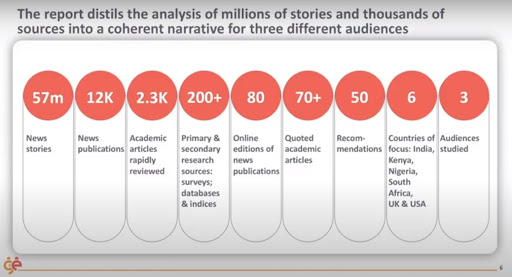The International Center for Journalists (ICFJ) is connecting journalists with health experts and newsroom leaders through a webinar series on COVID-19. The series is part of our ICFJ Global Health Crisis Reporting Forum — a project with our International Journalists’ Network (IJNet).
Women are underrepresented in news coverage today. We recently wrote about research that looked at the issue specifically in regards to COVID-19 reporting.
Last month the author of this research, audience strategy expert Luba Kassova, joined IJNet Managing Editor Taylor Mulcahey to discuss the representation of women across all news coverage today.
Kassova, who is the co-founder and director of the international audience strategy consultancy AKAS Ltd, recently released her latest report, The Missing Perspectives of Women in News. Kassova and her team analyzed 57 million articles for the research, from across 12,000 publications in six countries — India, Kenya, Nigeria, South Africa, the U.K., and the U.S. The researchers also looked at nearly 2,300 academic articles and more than 200 database surveys for the research.

Their analysis covered women’s representation in newsrooms and leadership positions, as well as their inclusion as sources and protagonists in news coverage, including gender equality angles in reporting.
Here are some key quotes and takeaways.
[Read more: What’s missing from COVID-19 coverage? Women.]
Women in newsrooms
- The news is “largely a men’s affair,” Kassova found. “Women are between two and six times less likely to be quoted as expert sources or protagonists in 2019 than men in the six countries which we analyzed,” she said, adding that no substantive progress has been made over the past 20 years.
- Among the 50 recommendations included in the report, Kassova offers news providers with a gender parity checklist that can be applied across all chains of news production. One of the actionable steps journalists can take is to access databases that house women experts, to help place them as protagonists in news stories. During the webinar, she pointed to progress made by Scandinavian countries and the South China Morning Post to compile easily accessible information to help journalists find experts.
- Kassova noted that: “South Africa leads in terms of gender equality legislation and also the proportion of women in newsrooms. The U.K. and the U.S. lead in terms of social norms and attitudes that are more favorable to gender equality.”
Women in leadership positions
- The report found that women hold only 26% of governance positions in news organizations, and just 27% of top management positions. These findings were consistent across all six countries, explained Kassova.
- Kassova further noted that based on research from academics, “Women tend to have more focus on empathy. At a management level, women are more likely to be collegiate rather than competitive with each other.”
- Since newsrooms tend to be dominated by men, the culture is more masculine and women are considered more likely to trade off their gender identity for their professional identity. This can be a barrier to seeing a difference in news coverage produced by women.
[Read more: The case for a gender editor]
Gender equality in news coverage
- Coverage of gender equality issues is virtually absent from the news. “Less than one percent of all news coverage in 2019 across any of the countries analyzed contained an element of gender equality in it,” said Kassova.
- “News is consumed more by men,” noted Kassova. When men are the main audience it helps determine the topics news outlets cover, she added, and this in turn affects women’s interest in the news. “There is a lot of value in testing the hypothesis, whether women consume less news because the news offered by news providers don't tailor to their needs as well as they tailor to men's needs,” said Kassova.
- “Women actually are more likely to be hooked in if there is a human interest angle within stories, and that very often is missing,” said Kassova. This could be important for local newsrooms as women tend to be more interested in news about the community, as well as solutions-based journalism.
- “Gender equality is not a priority for decision-makers or for journalists,” said Kassova. She referred to the 2019 GlobeScan-SustainAbility Survey in 2019 which showed that gender equality is often at the bottom of the list of urgent goals among global experts.
- “Patriarchal values are still alive and kicking both in the Global South but also in the Global North,” said Kassova. If women and minorities don’t think there is an issue, neither do the government and policymakers. Where there is complacency, she noted, progress stops because decision-makers don’t believe there is a problem to fix.
- “In order to achieve success, there is a need to tackle system-level factors, organizational factors, and individual journalist behaviors. If at any point or any level there is a barrier and blockage, then we are witnessing flat-lining, which has happened in the 21st century,” said Kassova.
Kassova offered several points of action to move past anti-women bias in the newsroom and in media coverage:
- Increase awareness of the strong anti-women biases in society and newsrooms.
- Remove barriers to advancing gender equality.
- Stage interventions that stimulate the creation of new habits, initiatives, and ways of thinking.
Said Kassova, “I hope we can all feel that by making a difference ourselves, we create a ripple effect in society and change can happen.”
Tedi Doychinova is a program officer at the International Center for Journalists.
Main image CC-licensed by Unsplash via Christina @ wocintechchat.com.
The Missing Perspectives of Women in News report was commissioned by the Bill and Melinda Gates Foundation. For further discussions on women in news, Kassova invites interested parties to connect with her via Twitter or Linkedin.

